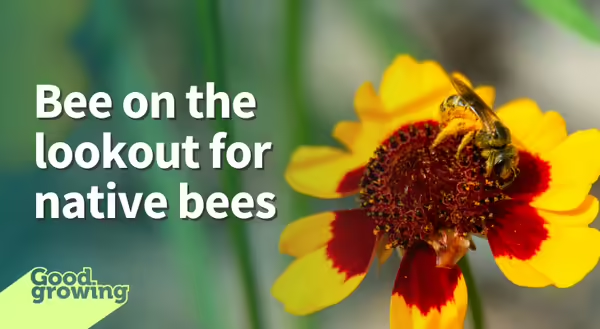
Now that we’re well into May, many landscapes are full of blooming plants and the buzz of bees. When you think of bees, what comes to mind? Chances are, images of golden-yellow honey bees come to mind. However, there is a lot more to bees than the honey bee. In fact, there are over 20,000 bee species worldwide and around 500 species of bees native to Illinois.
While honey bees live in colonies that can reach 60,000 individuals and bumble bees live in colonies that can reach 400 individuals, most (90%) native bees in Illinois are solitary bees. Unlike honey and bumble bees that have a division of labor where a queen lays eggs, and her offspring perform jobs such as caring for young, foraging, etc., female solitary bees do all of those jobs by themselves.
Most (70%) of our solitary bees nest in the ground. While others may nest in wood, hollow or pithy branches. Once she has selected a location, she will create nest cells. Inside these cells, she will place a ball of pollen mixed with nectar and lay an egg on it. When the egg hatches, the larva will feed on the pollen ball. Generally, these bees will not emerge until the following year.
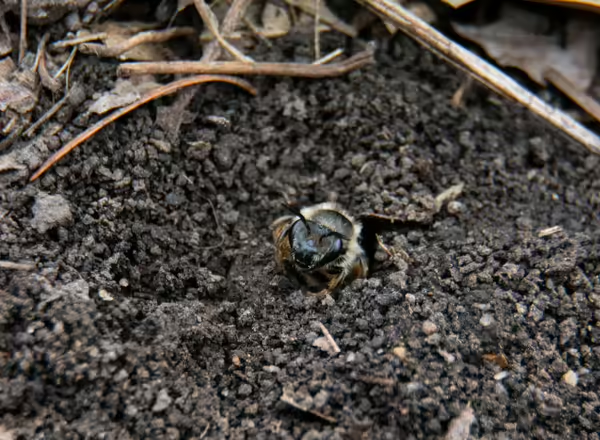
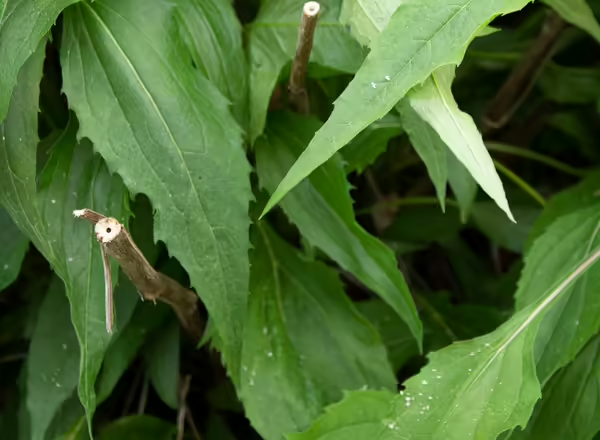
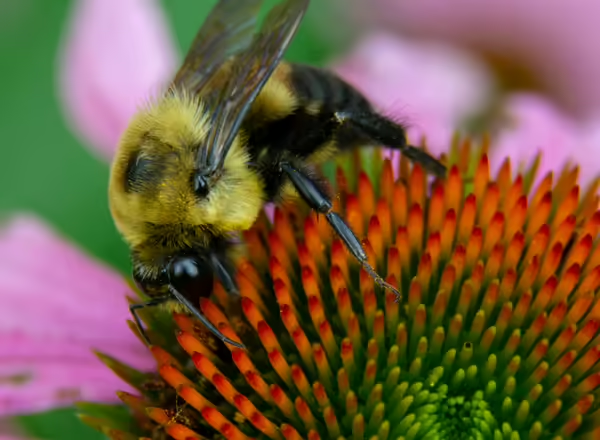
Bumble bees
Bumble bees get their name due to the buzz they produce while collecting pollen (buzz pollination). They are social insects, and colonies can have 50-400 individuals. Colonies will die off at the end of summer, and mated queens will hibernate. They are cavity nesters, often in abandoned underground rodent burrows, and are active from spring through late fall. They are large bees that are hairy with yellow, black, white, brown, or orange bands.
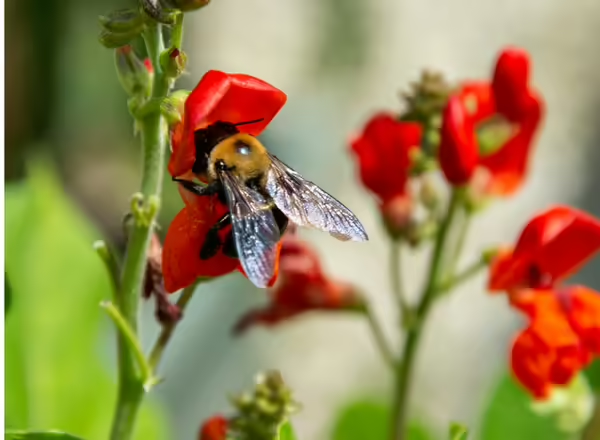
Eastern carpenter bee
Eastern carpenter bees are commonly considered pests because they often construct nests in the wood of homes and other buildings (painting wood can help prevent this). They are active from spring through fall. Due to their large size, they primarily visit large and open-faced flowers. They look similar to bumble bees. However, they are larger, and the top of their abdomen is bare, black, and shiny.
Small carpenter bees
These carpenter bees have weaker jaws than the larger Eastern carpenter bees. Since they are smaller and weaker, they nest in the pithy centers of dead stems. They are solitary nesters and are active from early spring through fall. They are small to medium-sized bees that are shiny and sparsely-haired and black, blue, or green, commonly with yellow or white markings on their faces.

Long-horned bees
Males have relatively long antennae giving them their name. Long-horned bees are solitary ground-nesting bees. Adult bees are present from mid-summer through fall and are most active in the morning and early afternoon. Many have a preference for sunflowers, and many species also visit asters. They are small to medium-sized bees that are hairy and often have abdominal bands of pale hairs.
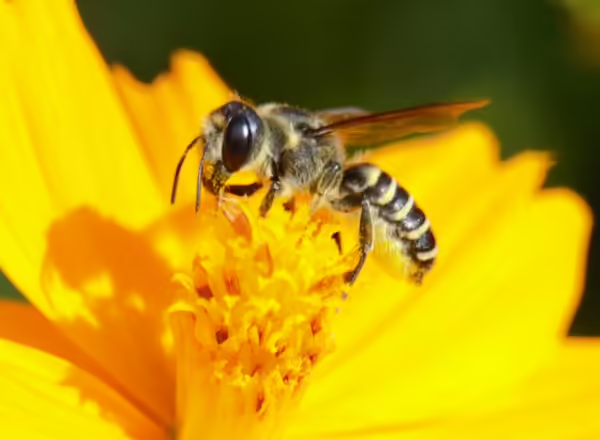
Leafcutter bees
These bees cut pieces of leaves or petals to line the walls of their nests. However, any damage to the plants is cosmetic. They are solitary nesting and create their nests in pre-existing wood and other plant cavities. Leafcutter bees are active from early to late summer. They are medium to large bees with smoky-colored stout bodies with pale bands on their abdomen.
Mason bees
Many of these bees collect mud to build walls in their nests to create brood (larval) cells giving them their common name, mason bees. These bees are solitary nesting and create their nests in pre-existing cavities such as beetle galleries and hollow plant stems. They will also nest in artificial nesting blocks. Mason bees are active from spring through early summer and are important pollinators of many fruit crops like apples, cherries, and plums. They are small to medium bees, and most are metallic in color (blue, green) and round wide abdomens with few, if any, markings or hair bands.
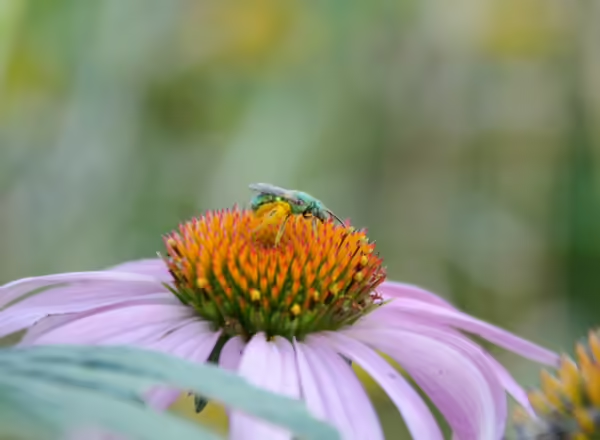
Sweat bees
Many species are attracted to human sweat that they will consume for its salt, thus their common name. Most sweat bees nest in the ground. Sweat bees can be found from spring through fall, with most species being active during the summer. They are small to medium-sized bees and are often brightly colored and metallic, with colors ranging from black to green to red and yellow.
Yellow-faced bees
These bees resemble wasps and are commonly mistaken for them. Unlike many other bees, yellow-faced bees do not have pollen-carrying structures. Instead, they carry pollen in their stomachs (crop) and regurgitate it once they return to their nests. They are solitary bees, nesting in pre-existing tunnels and wood-like stems and twigs. Yellow-faced bees can be found from late spring through late summer. They are small, slender bees and are hairless and black with yellow (sometimes white) markings on the face and sometimes on the thorax and legs.
Mining bees
These solitary bees nest in the ground, typically in sandy or other loose soils near or underneath shrubs. They often build a small mound outside the entrance of their nests. Mining bees are among the first bees to emerge in spring and are commonly seen in woodlands visiting flowers. Small to medium-sized bees, commonly black, dull metallic blue, or green and somewhat hairy with bands of hair on their abdomens.
Cellophane (polyester) bees
These bees get their name from the waterproof lining of their nests, allowing them to nest in moist soils unavailable to other bees. They are solitary ground-nesting bees; however, some species may nest in large aggregations. They are active from early spring through summer. Many cellophane bees are specialists and only visit a small range of plant species. Small to medium-sized bees that are slender and hairy.
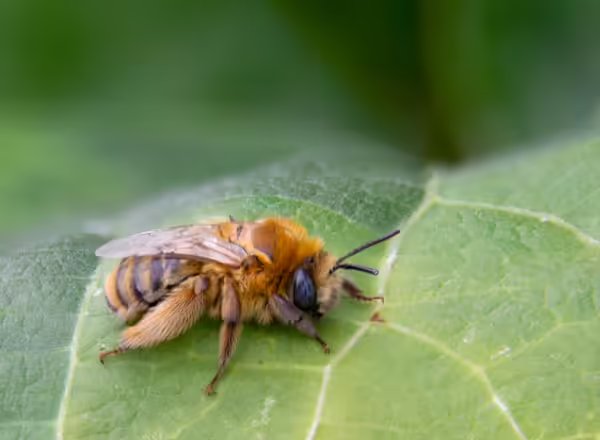
Squash bee
The squash bees get their name because they are specialists on squashes, pumpkins, and gourds. They are much more efficient at pollinating these plants than many other bees, such as honey bees. They are solitary ground-nesting bees, often right next to squash plants. Adult bees are active from dawn until midday while squash plants are blooming (mid-summer). The squash bee is a medium-sized bee that looks similar to honey bees. However, the squash bee is larger and thicker and has longer antennae and a rounder face.
Like honey bees, native bees are also important pollinators. In many cases, they are more effective and efficient pollinators compared to honey bees, especially when it comes to native plants. So, take a moment to stop and enjoy our native bees.
Good Growing Tip of the Week: Native bees are generally much more reluctant to sting when compared to honey bees and wasps, often only stinging when squished or handled.
References and for more information
Holm, Heather. Pollinators of Native Plants: Attract, Observe and Identify Pollinators and Beneficial Insects with Native Plants. Minnetonka, MN: Pollination Press LLC, 2014.
Mäder Eric, Mathew Shepherd, Mace Vaughan, Scott Hoffman Black, and Gretchen LeBuhn. Attracting Native Pollinators: Protecting North America's Bees and Butterflies: The Xerces Society Guide. North Adams, MA: Storey Publishing, 2011.
Wilson, Joseph S., and Olivia Messinger Carril. The Bees in Your Backyard: A Guide to North America's Bees. Princeton, New Jersey: Princeton University Press, 2016.
Signup for our emails! Want to get notified when new Good Growing posts are available? SIGN ME UP
MEET THE AUTHOR
Ken Johnson is a Horticulture Educator with University of Illinois Extension, serving Calhoun, Cass, Greene, Morgan, and Scott counties since 2013. Ken provides horticulture programming with an emphasis on fruit and vegetable production, pest management, and beneficial insects. Through his programming, he aims to increase backyard food production and foster a greater appreciation of insects.